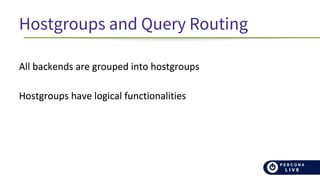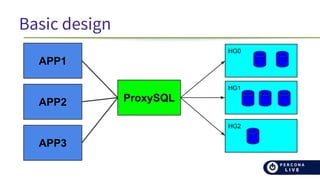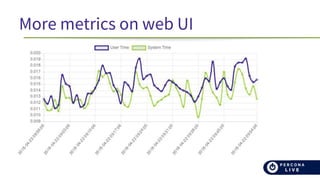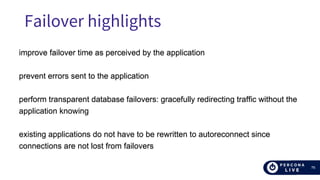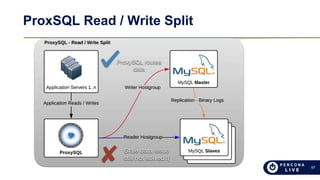Ad
HandsOn ProxySQL Tutorial - PLSC18
- 1. Santa Clara, California | April 23th – 25th, 2018 ProxySQL Tutorial High Performance & High Availability Proxy for MySQL With a GPL license!
- 2. 2 Who we are René Cannaò ProxySQL Founder Derek Downey Director of OSDB, Pythian
- 3. 3 Agenda ● What is ProxySQL? ● Features ● Fundamentals ● What is new? ● Internals ● Admin ● Clustering ● Rules ● Mirroring ● Failover ● New protocols ● GTID casual reads
- 4. 4 Other sessions Consistent Reads Using ProxySQL and GTID Tuesday April 24, 2018 @3:50PM Automatic Failovers with Kubernetes using Orchestrator, ProxySQL and Zookeeper Tuesday April 24, 2018 @3:50PM
- 6. 6 What is ProxySQL The MySQL data stargate
- 7. 7 Main motivations empower the DBAs improve operation understand and improve performance create a proxy layer to shield the database High performance and High Availability
- 8. ProxySQL Features Some of the most interesting features: ● on-the-fly rewrite of queries ● caching reads outside the database server ● connection pooling and multiplexing ● complex query routing and read/write split ● load balancing ● real time statistics ● monitoring ● Data masking ● Multiple instances on same ports
- 9. ProxySQL Features (2) Some of the most interesting features: ● High Availability and Scalability ● seamless failover ● firewall ● query throttling ● query timeout ● query mirroring ● runtime reconfiguration ● Scheduler ● Support for Galera/PXC and Group Replication
- 11. What’s new in ProxySQL 1.4.0 Native Support for Group Replication Multiple regex engines Better performance Support for millions of users Support for tens of thousands of database servers Better queries control http://www.proxysql.com/blog/releasing-proxysql-140
- 12. What’s new in ProxySQL 1.4.7 Native ProxySQL Clustering Solution Support for ClickHouse as a backend SQLite network Support for millions of shards
- 13. What’s new in ProxySQL 2.0 (dev) … all in 1.4.x plus: Support for Aurora SSL support for frontend SSLv1.2 Native Support for Galera Causal reads using GTID Multi-threaded connections reset
- 14. Hostgroups and Query Routing All backends are grouped into hostgroups Hostgroups have logical functionalities
- 15. Hostgroups example #1 HostGroup0 (HG0): Write masters HostGroup1( HG1): Read slaves Read/Write split
- 16. Hostgroups example #2 HG0: main write masters HG1: main read slaves HG2: reporting slaves HG3: ad-hoc queries slaves HG4: data warehouse write masters HG5: data warehouse read slaves HG6: remote site servers HG7: test servers HG8 : mirror for traffic on HG0 HG9 : mirror for traffic on HG1
- 18. Basic design HG0 HG2 HG1 APPAPP ProxySQL Very low latency using Unix Domain Socket (?)
- 19. One ProxySQL per host
- 20. Silos approach
- 21. Clustered ProxySQL Architecture DB DBDB APP DB PROXYSQL DB DB APP PROXYSQL APP PROXYSQL APP PROXYSQL PROXYSQL PROXYSQL DBMANAGER PROXYSQL Clustered Proxy Layer
- 22. Clustered ProxySQL at scale Tested with: ● 8 app servers with 3k clients’ connections each (24k total) ● 4 middle layer proxysqls processing 4k connections each from local proxysqls (16k total) ● 256 backends/shard (meaning 256 routing rules) processing 600 connections each (150k total) Single ProxySQL was tested with up to 950k connections At today, ProxySQL is able to process up to 750k QPS
- 24. ProxySQL Modules in 1.3.x HG0 HG1 APP1 ProxySQL Queries cache Query Processor APP2 APP3 Thread#1 Thread#2 Thread#3 Users Auth Connection Pool Hostgroup Manager Admin Monitoring
- 25. ProxySQL Modules in 1.4.x HG0 HG1 APP1 ProxySQL Queries cache Query Processor APP2 APP3 Thread#1 Thread#2 Thread#3 Users Auth Connection Pool Hostgroup Manager Admin Monitoring ClickHouse Server ClickHouse Auth Cluster SQLite3 Server Thread#3idles Thread#2idles Thread#1idles Purge Thread
- 26. Queries Processor Based on Queries Rules Defines what to cache Defines the hostgroup target Timeout/delay Firewall Mirroring Rewrite queries
- 27. Queries rules Complex rules to match incoming traffic: ● regex on query ● regex on digest text ● username ● schemaname ● Source IP address ● Bind IP address/port ● digest Rules can be chained
- 28. Queries Cache and Rewrite Caching on the wire Internal key/value storage In memory only Pattern based Expired by timeout Rewrite on the wire Regex match/replace on query on digest text Optionally cached or mirrored
- 29. Users Authentication Credentials stored in the proxy User login always possible (even without backends) Max connections Login credentials are encrypted Extremely scalable, up to millions of users: https://www.percona.com/live/e17/sessions/scaling-million-databases-000webhost-lt
- 30. Hostgroups Manager Management of servers Track servers status Tightly integrated with the connections pool
- 31. Connections Pool Reduced the overhead of creating new connections, and are recycled when not in use One to many connections Multiplexing & maximum connections Auto-reconnect and automatic re-execution of queries Failover management
- 32. Purge Thread Unsafe connections are reset instead of being dropped Drastically reduce the need to establish new connections In ProxySQL 2.0 : each worker thread perform most of the reset
- 33. Auto-reconnect and re-execution Automatic detection of failures Graceful handling Auto-reconnect when possible Pause until a backend becomes available Re-execution of queries
- 34. Multiplexing Reduce the number of connections against mysqld (configurable) Many clients connections (tens of thousands) can use few backend connections (few hundreds) Tracks connection status (transactions, user variables, temporary tables, etc) Order by waiting time
- 35. Multiplexing (see it in web UI)
- 36. Multiplexing (see it in web)
- 37. More metrics on web UI
- 38. More metrics on web UI
- 39. More metrics on web UI
- 40. Monitoring Module It monitors backends and collects metrics Monitors replication lag and shun hosts Monitors read_only (and super_read_only and innodb_read_only in 2.0) variables (replication hostgroups) Ping and terminates unresponsive nodes
- 41. Monitoring Module Built in support for asynchronous replication: second behind master and pt-heartbeat Support for any type of clustering solution via external scripts (Galera/PXC , and any heterogeneous replication setup) In ProxySQL 1.4.0, support for Group Replication In ProxySQL 2.0, support for Galera
- 42. Admin Module
- 43. Admin Interface Allows runtime configuration Exports internal statuses It uses MySQL protocol Configuration possible from any client/tool using MySQL API Covered during the tutorial
- 45. Try it! Source code on GitHub: https://github.com/sysown/proxysql/ Forum: https://groups.google.com/forum/#!forum/proxysql Tutorials on: http://www.proxysql.com
- 46. Demo Environment
- 47. 47 Demo Code on GitHub: https://github.com/renecannao/ProxySQL-Tutorial-PLSC2018 Some hosts provided: Username: plsc Passwords: proxysql
- 48. ProxySQL Cluster
- 49. ProxySQL Cluster New in 1.4.2 – experimental (not fully completed, subject to change) Support for MySQL Query Rules, MySQL Users, MySQL Servers and ProxySQL Servers A group of instances constantly check each other for changes in configuration A configuration change applied in a proxy is pulled by the other proxies Allow to keep multiple ProxySQL instances with the same configuration(s)
- 50. ProxySQL Cluster
- 51. ProxySQL Cluster Conflict resolution is timestamp based • No order • Last win No quorum (in the roadmap) Highly scalable: Core nodes vs satellite nodes
- 52. 52 ProxySQL Cluster - Config mysql> SET admin-cluster_username='radmin'; mysql> SET admin-cluster_password='radmin'; mysql> LOAD ADMIN VARIABLES TO RUNTIME; mysql> SAVE ADMIN VARIABLES TO DISK; mysql> INSERT INTO proxysql_servers (hostname) VALUES ('proxysql1'),('proxysql2'),('proxysql3'); mysql> LOAD PROXYSQL SERVERS TO RUNTIME; mysql> SAVE PROXYSQL SERVERS TO DISK; mysql> SHOW VARIABLES LIKE 'admin-cluster%'; +---------------------------------------------------+--------+ | Variable_name | Value | +---------------------------------------------------+--------+ | admin-cluster_username | radmin | | admin-cluster_password | radmin | | admin-cluster_check_interval_ms | 1000 | | admin-cluster_check_status_frequency | 10 | | admin-cluster_mysql_query_rules_diffs_before_sync | 3 | | admin-cluster_mysql_servers_diffs_before_sync | 3 | | admin-cluster_mysql_users_diffs_before_sync | 3 | | admin-cluster_proxysql_servers_diffs_before_sync | 3 | | admin-cluster_mysql_query_rules_save_to_disk | true | | admin-cluster_mysql_servers_save_to_disk | true | | admin-cluster_mysql_users_save_to_disk | true | | admin-cluster_proxysql_servers_save_to_disk | true | +---------------------------------------------------+--------+ 12 rows in set (0.00 sec)
- 53. 53 ProxySQL Cluster - Monitoring Stats_proxysql_servers_checksums Stats_proxysql_servers_metrics
- 57. 57 Query rewriting examples read/write splitting Data masking Sharding
- 59. Match Related Tables mysql_users • active • fast_forward(bypass) mysql_query_rules • username • schemaname • flagIN/OUT • client_addr • proxy_addr • proxy_port • digest • match_digest • match_pattern • negate_match_pattern
- 61. 3 layers for ProxySQL tables Disk Memory Runtime Runtime Memory DiskConfig
- 62. Precautions Confirm the query hits with stats_mysql_query_rules double check rules and rewrite results hold off on writing rules to disk until you're sure they are working as expected have a rollback plan • load from disk, • then load from memory to runtime test select query rules and rewrites on a slaves first test mutable rules on a mirror or other throw away db.
- 63. 63 Example - Simple R/W mysql> SELECT username, default_hostgroup FROM mysql_usersG *************************** 1. row *************************** username: root default_hostgroup: 0 1 row in set (0.00 sec) mysql> SELECT match_digest, destination_hostgroup FROM mysql_query_rulesG *************************** 1. row *************************** match_digest: ^SELECT.*FOR UPDATE destination_hostgroup: 0 *************************** 2. row *************************** match_digest: ^SELECT destination_hostgroup: 1 2 rows in set (0.00 sec)
- 64. Query Rewriting with ProxySQL DEMO Click to add text
- 65. Mirroring with ProxySQL Click to add text
- 68. 68 Why mirror queries? Validate performance on a different server using different hostgroups. Validate performance of query rewrite or schema change Pre-fetch slave replication (Replication Booster)
- 69. 69 How to mirror mysql>SHOW CREATE TABLE mysql_query_rulesG *********************** 1. row ************************ table: mysql_query_rules Create Table: CREATE TABLE mysql_query_rules ( rule_id INTEGER PRIMARY KEY AUTOINCREMENT NOT NULL, active INT CHECK (active IN (0,1)) NOT NULL DEFAULT 0, username VARCHAR, schemaname VARCHAR, flagIN INT NOT NULL DEFAULT 0, *snip* mirror_flagOUT INT UNSIGNED, mirror_hostgroup INT UNSIGNED, error_msg VARCHAR, *snip*)
- 71. 71 Mirroring - example #1 mysql> SELECT username, destination_hostgroup, mirror_hostgroup, mirror_flagOUT FROM mysql_query_rules WHERE username='plam_mirror'G ****************** 1. row ********************** username: pl_mirror destination_hostgroup: 3 mirror_hostgroup: 4 mirror_flagOUT: NULL
- 72. 72 Mirroring - example #2
- 73. Mirroring Demo Click to add text
- 74. 74 Mirroring caveats Can be dropped: mysql-mirror_max_concurrency, mysql-mirror_max_queue_length Can be executed out of order No error handling of failed queries
- 76. 76 Failover highlights improve failover time as perceived by the application prevent errors sent to the application perform transparent database failovers: gracefully redirecting traffic without the application knowing existing applications do not have to be rewritten to autoreconnect since connections are not lost from failovers
- 77. 77 Failover scenario - without ProxySQL
- 78. 78 Failover scenario - without ProxySQL
- 79. 79 Failover scenario - with ProxySQL
- 80. 80 Failover scenario - with ProxySQL
- 81. 81 Failover scenario - with ProxySQL
- 82. 82 Failover scenario - with ProxySQL
- 83. 83 Failover without ProxySQL (10 minute outage) https://www.nylas.com/blog/growing-up-with-mysql/
- 84. 84 Failover with ProxySQL (10 second outage) https://www.nylas.com/blog/growing-up-with-mysql/
- 85. 85 Failover - MySQL Servers mysql> SELECT hostgroup_id, hostname, status FROM mysql_servers WHERE hostname IN ('mysql1, 'mysql2’)G *************************** 1. row *************************** hostgroup_id: 0 hostname: mysql1 status: ONLINE *************************** 2. row *************************** hostgroup_id: 1 hostname: mysql2 status: ONLINE 2 rows in set (0.00 sec)
- 86. 86 Failover - Replication Hostgroups mysql> SELECT * FROM mysql_replication_hostgroupsG *************************** 1. row *************************** writer_hostgroup: 0 reader_hostgroup: 1 comment: 1 row in set (0.00 sec)
- 87. 87 ProxySQL Failover ProTIP ProxySQL does not handle promotion or re-slaving External process needed, such as MHA or Orchestrator
- 88. Failover Demo Click to add text
- 89. New Features Click to add text
- 90. ClickHouse Server New in 1.4.3 – experimental (not fully completed, subject to change) Support for ClickHouse: https://clickhouse.yandex/ Fast, really fast data analytics using MySQL client Users management Supports only one backend Supports only DDL and SELECT (no INSERT)
- 93. SQLite3 Server New in 1.4.3 – experimental (not fully completed, subject to change) Support for SQLite3 : https://www.sqlite.org/ Fully transactional, in-memory Same users as MySQL backends A lot of features in the roadmap
- 94. You-Name-It Server What other service should become part of ProxySQL ?
- 95. You-Name-It Server What other service should become part of ProxySQL ?
- 96. Causal read with GTID Feature introduced in 2.0 Ensures that reads sent to slave returns what the client has written on master Requires GTID and MySQL 5.7+
- 97. 97 ProxSQL Read / Write Split
- 100. 10 0
- 101. We offer support Subscriptions Consulting Professional services
- 102. 10 2 Rate My Session
- 103. Thank You!













